Or – “A Moment When I Wondered If I Could Even Write AT ALL…”
**Please note that today’s Retro Review is not for the faint of heart or the easily offended, and images may be considered NSFW. Those who are sensitive to depictions of violence should NOT click the link.**
Day 2 of Anniversary Week, and we continue our look at stories that have great power and meaning for me. If you listen to the Major Spoilers Podcast, you know I talk a lot about things my Grandfather may or may not have actually said. On occasion, though, I have to divert to the wisdom of my late Grandmother, a teacher for 70-odd years. Gramma used to say, “scratch a critic and find a failed writer. ” While what I do is probably only criticism in the loosest sense of the word, there might be a grain of truth to that truism for me. One of the major reasons why I never seriously pursued a career in comic book writing was the existence of Alan Moore. When I first read his Swamp Thing issues in 1980-whichever, I was so stunned as to wonder why I even bothered with my scrawlings in the first place, so powerful and evocative is his writing. Moore’s 80’s work seemed determined to assess and deconstruct every aspect of comics and the superhero and Miracleman is still (in my mind, anyway) his magnum opus. He took issue with such comic tropes as the secret identity, the evil scientist, the relationship between man and superman, all against the Cold War nuclear panic backdrop of the 1980s.
With issue #15, Moore seemingly decided to completely recreate that staple of comic books, the fight scene. The resulting issue is one of the most compelling and HORRIFYING comic books ever put to paper, and one of the crown jewels of my collection…
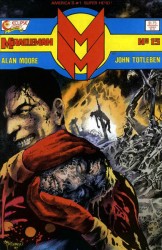 Miracleman #15
Miracleman #15
Script: Alan Moore
Pencils: John Totleben
Inks: John Totleben
Colors: Sam Parsons
Letters: Wayne Truman
Publisher: Eclipse Comics
Previously, on Miracleman: Micky Moran’s story has a very familiar ring to it. A young reporter encounters a strange old man who teaches him a magic word that transforms him into an older superhuman version of himself, which sounds remarkably familiar to the origin of Fawcett Comics’ Captain Marvel. (It should, as Miracleman’s genesis was as Marvelman, a character created for British reprints when Captain Marvel himself stopped publishing due to DC’s copyright lawsuit terms.) The old man, though, was an astrophysicist rather than a wizard, and the word was “Kimota” (Atomic spelled backwards, ostensibly) rather than “Shazam.” And, of course, there’s the fact that it’s all bull$#!+.
Micky and his proteges Young Miracleman and Kid Miracleman were the end results of a military experiment created by a genius named Gargunza, and they were all attacked with a nuclear weapon (!!) when their usefulness ran out. Having returned to being in the 1980s, Miracleman is at first gratified to see his old pal Kid Miracleman all grown up, but soon finds that little Johnny Bates spent 30 years in his superhuman state, becoming more and more psychotic and evil as he went. Their first battle ended with a miraculous (no pun intended) win for MM, as his kid sidekick accidentally returned to his human form after 3 decades. A chance encounter with bullies caused little Johnny to use his magic word again, and ran roughshod over the city of London while Miracleman was away. The sheer horror and power of this situation comes clear with the first view of Johnny Bates, perfectly comfortable amid the carnage that he has created, waiting for his former mentor to return…
Wanna know what’s really amazing about this issue? Senseless violence, including some pretty obvious violence against children, but I’m too caught up in the story being told for my Berzerk Button to engage. That’s craft, Faithful Spoilerites. John Totleben first caught my eye as the penciller of Swamp Thing, but his work here is truly visionary (in an awful, terrible, apocalyptic sense) showing what might happen if someone with nigh-infinite power really went mad and began destroying things. We’re treated to images of human skins drying on clotheslines, people stacked artistically and impaled on buildings for decorative purposes… It’s a truly monstrous introduction to what Bates is capable of. Miracleman and his allies are stunned at the sight of Bates’ handiwork. By this point in the series, Moore’s Miracleman has begun referring to himself as God, speaking of his infallibility and omniscience, but even he is affected. Moore’s internal monologue for the character is simply amazing…
“Really… What MUST one do to get attention around here?” crows the former Kid Miracleman as the others attack, confirming his status as pure evil. The real masterstroke, though, is that in issues just previous, I felt SORRY for him, being abused and hazed in a boy’s school. When he spoke the word to save himself from an assault, part of me cheered for Bates overcoming his attackers. And then he murdered them all in disgusting and innovative ways. Moore made me feel for a nasty little bastard and then made his true colors even more vivid and awful than anything I’d ever seen. As the battle continues, Miracleman begins to describe how the battle has become legend, that apocryphal tales of what happened that day have sprung up, and then begins telling us THOSE stories…
Interestingly, in one of the earliest appearance of the character (as Marvelman, mind you) back in Warrior comics, he was attacked on the moon by his future self and a Warpsmith, claiming that a terrible battle was happening in the future. The way it’s structured here, though, it’s unclear whether Moore (or indeed Miracleman) is verifying that tale as here, or dismissing it as apocrypha itself. “How baroque these myths,” indeed. Half a dozen more explanations are given as well, the upshot of all being that Miracleman returned with enough power to challenge Bates on his own terms, and the two supermen begin a physical battle that returns to the center of London. Those of you who heard Stephen’s recent discussion on a podcast about casualties of superhuman fights should know that I kept wanting to reference this issue, but forgot. Either way, it becomes clear that the line between Bates and Moran isn’t so much one of morality as it is one of degree.
It’s actually the Warpsmith (another Moore creation from Warrior Magazine, where his take on Marvelman first appeared) who strikes the successful blow on Kid Miracleman, teleportin rubble into his brain and heart (!!) and forcing him to save himself by transforming back into Johnny Bates, a squishy little 13-year-old boy whose mind hides a monster. Miracleman uncharacteristically reaches out to comfort the boy, and then…
…yeah. Oh. My. Gawd. The sheer happiness on little Johnny’s face in that last panel is heartbreakingly pathetic, and the first time I read the issue, I simply COULD NOT believe what had just happened in the issue. The hero is left weeping, cradling the broken body of a barely teenage boy, in the midst of a completely devastated London. The city is actually never rebuilt, serving as a permanent memorial to the millions murdered by Johnny Bates that day, and Miracleman ends up building his castle in the ruins and then TAKING OVER THE WORLD because he believed that no one else was fit to rule. Let’s look at that sentence again: In order (partly) to keep something like London from happening again, Miracleman set himself up as the (mostly) benevolent dictator of the entire world. Imagine Clark Kent or Mar-Vell trying that one in their respective realities for a second… Yeah, I didn’t think so.
The most amazing thing about this issue is that Miracleman the series doesn’t really HAVE a lot of giant fisticuff battles, instead focusing on what the superhuman in their midst really means, and in one case spending most of an issue witnessing the birth of Miracleman and Liz Moran’s child. Neil Gaiman would take over the series an issue or two later, and send it off in another, more esoteric direction, but Moore’s sixteen issues of the book represent as realistic a portrayal of superhumans as I’d ever read at the time. Even Doctor Manhattan doesn’t go to the extremes that Miracleman does, yet none of his actions ever seem terribly unreasonable at the time, even his extreme sanction of the mad Kid Miracleman. It’s really sad that routine and petty legal squabbles have kept this remarkable book from ever being completed (or, indeed, reprinted) for so long that many Spoilerites profess that they don’t understand what made the damn thing so interesting. Short form? Miracleman strikes that elusive balance between superheroes and the real world that comics like “Shadowland” and “Return Of Bruce Wayne” strive to create, showing us a recognizable “real world” where the guy in the funny suit doesn’t embarass us. Miracleman #15 is the total package, and has forced me to do the unthinkable, breakin the scale and earning 6 out of 5 stars overall… (At least until Stephen tells me to change it.)
Faithful Spoilerite Question Of The Day: How many of you have ever actually gotten to SEE an issue of Miracleman? (Otter Disaster doesn’t count, as he bought issue #1 and 2 straight out of a dollar bin back in the day, if I recall correctly…)




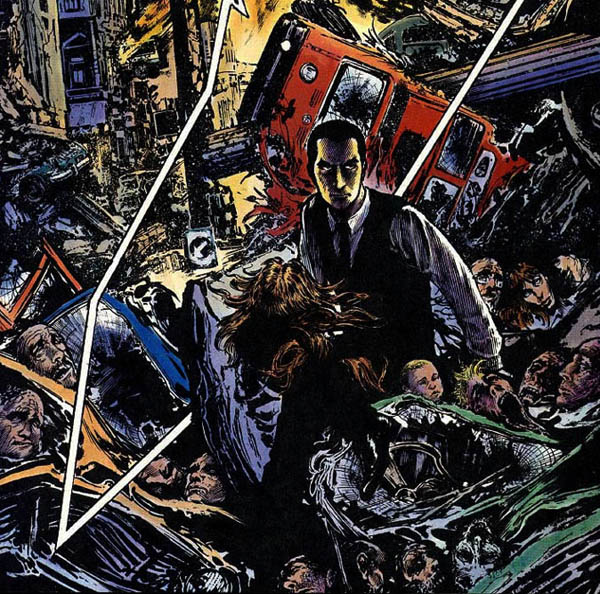
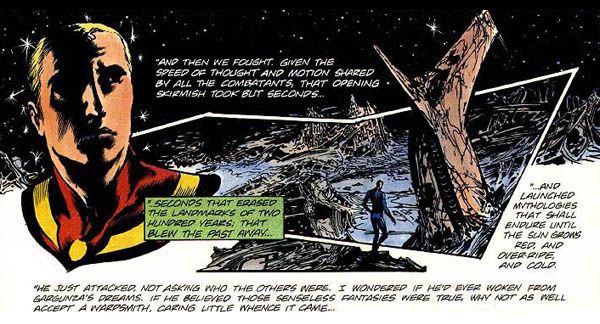
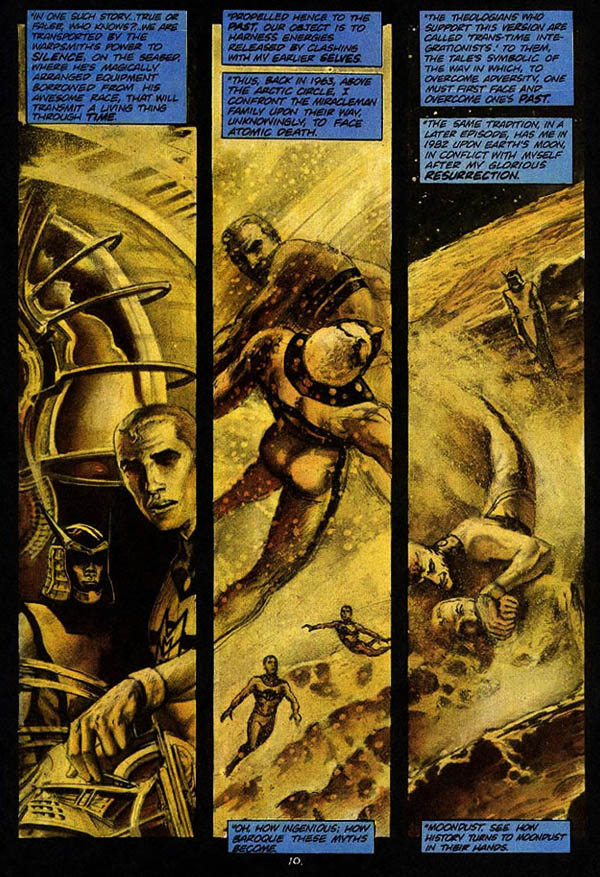
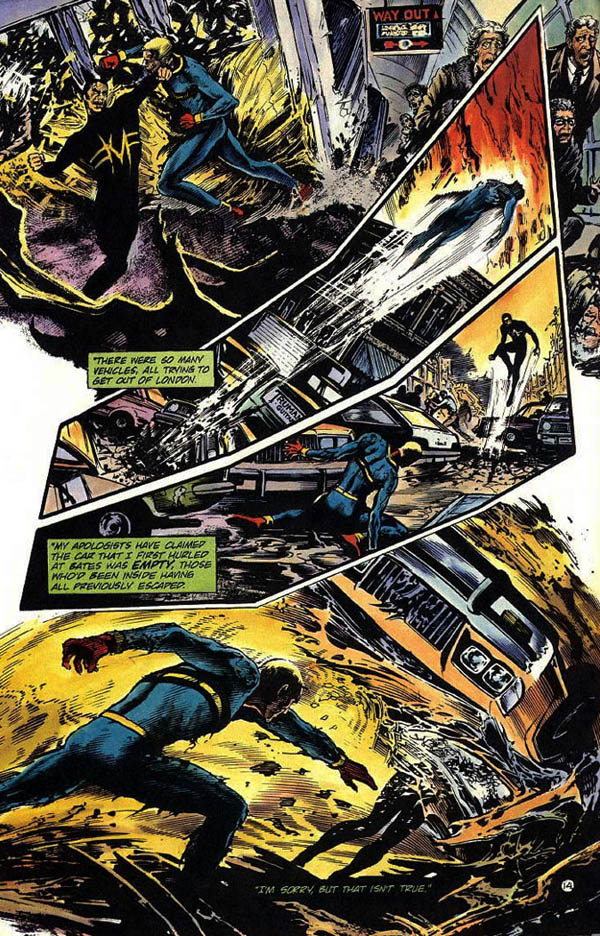

22 Comments
Great review, though I think your rating is a little low for this issue.
I bought this series when it came out at the stands, though for some reason I’m missing #15 from the Alan Moore run. It was only a couple of years ago when I finally was able to read this issue.
Stupid legal fighting kept Spiderman off the big screen for years, and it has done the same with this series. This series makes more sense as the legality of it even being originally printed was in question. The rights were not purchased by Moore (et. al) to do the series (to the best of my understanding).
Stupid legal fighting kept Spiderman off the big screen for years, and it has done the same with this series. This series makes more sense as the legality of it even being originally printed was in question. The rights were not purchased by Moore (et. al) to do the series (to the best of my understanding).
Well, Dez Skinn was the editor at Warrior Magazine, and the accounts that I’ve heard have Moore and original artist Garry Leach being given at least tacit assurance by Dez that the rights had been purchased legally. The fact that Mick Anglo was able to successfully sell his stories to Marvel may or may not support that claim, I’m not sure, but the creators DO at least own the rights to their specific works.
>>but the creators DO at least own the rights to their specific works.
Not being a lawyer, I don’t know how this works. If I wrote and illustrated a Superman story (which I don’t have the right to sell), I wouldn’t think anyone would have the right to reprint and sell it unless the original material was considered public domain. Or the original copyright was purchased also. Or permission was given by the original copyright owner. Yes the creators own the rights to their works, but that doesn’t mean it can be marketed without permission from the original copyright owner.
I don’t recall reading, did Marvel purchase the Moore/Gaiman (et. al) series or just the original. I understand that on the Moore/Gaiman series, the artist, writer, and publisher each owned a third. And when the artist changed, they owned their third. So this makes several people involved who would need to have their copyrights purchased. Didn’t McFarlane purchase the publishers third. I don’t recall in the recent Marvel stories about them buying the copyright from any of these players.
Not being a lawyer, I don’t know how this works. If I wrote and illustrated a Superman story (which I don’t have the right to sell), I wouldn’t think anyone would have the right to reprint and sell it unless the original material was considered public domain. Or the original copyright was purchased also. Or permission was given by the original copyright owner. Yes the creators own the rights to their works, but that doesn’t mean it can be marketed without permission from the original copyright owner.
Yep. But the copyright owner can’t just reprint Gaiman, Moore and company’s stories because they own the rights to Miracle/Marvelman. Those tangible properties, to my understanding, still belong to their creators, even if they can’t publish ’em. I believe that Marvel has only purchased Mick Anglo’s Marvelman rights, but could be wrong. McFarlane’s ownership claim seems to be the major stumbling block to these things seeing the light of day again, from what I understand.
>>But the copyright owner can’t just reprint Gaiman, Moore and company’s stories because they own the rights to Miracle/Marvelman.
Agreed.
>>I believe that Marvel has only purchased Mick Anglo’s Marvelman rights, but could be wrong.
Boo Hiss. No one is excited about this. And I don’t think it was clear in the announcements. How are the reprints of these selling for you? I haven’t sold any.
>>McFarlane’s ownership claim seems to be the major stumbling block to these things seeing the light of day again, from what I understand.
So you think Moore is willing to sell his? To Marvel? He passed on the copyright of his third to Gaiman, but does that mean he still owns a third of the copyright for #1-#16, or does Gaiman own one third of #1-#24?
How are the reprints of these selling for you? I haven’t sold any.
Not so well… I think the price point is way too high for a black and white reprint of such… Um… Let’s be kind and say “whimsical” art. It’s good stuff, but it’s not necessarily four or five bucks worth of good stuff.
So you think Moore is willing to sell his? To Marvel? He passed on the copyright of his third to Gaiman, but does that mean he still owns a third of the copyright for #1-#16, or does Gaiman own one third of #1-#24?
I want to say that Moore has come out and said that he signed his portion over to the new creators, but I’d have to do some research to be certain.
One of the all time best damn comics written EVER!
Chip
BOOM!
Amen!
Read them all through a friend. This one is the game changer. 100 stars.
I own most of the run, but 15 is just a WEE bit beyond my price point. I have read all the digital versions and issue 15 is a rare instance where the product MORE than lives up to the hype.
When you consider the TIME these stories were published, it really is quite damaging to the fragile potential writer’s ego.
Love this book.
I’m a proud owner of the Miracle Man run. I think I’m only missing the “Warpsmith” story (2 page stories from Warrior, IIRC) than ran “simultaneous” to this issue.
Like 99% of Alan Moore’s work, it demonstrated what a comic book NEEDS to do in order to tell a certain type of story: Geoff Johns’ “Superboy Prime” is a weak dilute of the pure essence of Kid Miracleman.
I’m a proud owner of the Miracle Man run. I think I’m only missing the “Warpsmith” story (2 page stories from Warrior, IIRC) than ran “simultaneous” to this issue.
Weird aside… When my sister got married when I was in college (possibly early 1990?), I drove halfway across the state in a truck with no heat during a blizzard to a small town in the Flint Hills of Kansas whose name escapes me. Didn’t even have a Wal-Mart, just a Duckwalls five and dime store… There, in a bin with old Whitman 3 for a buck comics, was the issue of Warrior (Number 4, if memory serves) in which Miracleman is attacked by his own future self.
Bought it for 50 cents as the cover said 50p. They guy laughed that I was probably getting gypped…
I don’t believe I was.
>>the new creators, but I’d have to do some research to be certain.
That’s what I remember also. So that would make Gaiman the owner of Moore’s piece (I guess).
There was a magazine a few years back that talked about this. “Kimota” if I remember.
Thanks for the great review.
I have a Miracelman run, and this review is giving me the need to break out my run and read it all over again. I think they may never get the complete series reprinted, so I will treasuer my collection, even if my Golden Age arc is a TPB instead of the individual issues.
In my opinion Miracleman is a far superior tale of Superhero in the Realworld than Watchmen could ever be. It address’ the silly costumes, has real bad guys, and spans the scope of human and god-like nature.
I’ve actually done quite a bit of reading on Miracleman/Marvelman/Sentry Sr and from what I’ve parsed together, Moore passed along his percentage ownership to Gaiman. It was very much a gentleman’s agreement early in their careers. In retrospect, I’m sure that EVERYONE involved would have been more resolute in their contractual negotiations.
Moore wants nothing to do with ANY of it, and if it helps Anglo, he’s gone on record as saying he’s cool with the reprint. I’m sure Marvel would like to play nice/nice with Moore so that they can avoid the fervent backlash that DC continually faces when dealing with Moore properties.
Gaiman has said he still has his story to finish and his fight with Todd is obviously more than a dispute over Angela, Medeval Spawn, etc.
Marvel will be printing money if and when they put out a collection of their work. I imagine 2 oversized hardcovers. Perhaps they will have a supplement book with annotated stuff, sketches, etc.
We should be seeing a new version of Khoury’s Kimota! a few months before the release of the Moore/Gaiman run, that would be my best guess.
But did Marvel purchase the Gaiman (and all the artists who were involved), and McFarlane rights?
Here is what Stacy B wrote as of a year ago… http://www.majorspoilers.com/hero-history-from-hand-to-hand-the-strange-case-of-marvelman
Marvel is being deliberately obtuse about that topic. This year at SDCC Joey Q took a question during his panel, asking when we’d see the long out of print MM material.
Q gave a rehearsed answer that said Anglo is in failing health and Marvel really wanted to see his original stuff released to the public before any of the later stuff. But…he then said that he thinks he knows what we’re asking about and his answer was to “be patient.”
So, we’ve got that going for us. Which is good.
In a perfect world, the estate of the talented 1950s Marvelman artists will all be paid for Marvel reprinting their material. Mick may be the sole survivor but his main role was, after all, the editorial packager for most of the strips whose fee was the difference between the total budget and how much of it he spent on contributors (which might explain the often-mentioned page rate of only £1 – aka $4 – at the time). He got a budget to put them together and hired artists to do so. It’s down to Don Lawrence (so talented that he was made a Knight of Orange for his reprinted Storm and Trigan Empire work in Holland) and Roy Parker that there’s well produced art for Marvel to “draw” from for these overpriced books.
But I’ve heard diddly squat from them for about 12 years on this, since Joe and I had dinner at the Hilton in London. They know I own Big Ben and Quality bought world rights on the lettering too! Garry Leach co-owns the Warpsmiths with Alan Moore (two by 6 page solo strips in Warrior, BTW!) and I gather he’s heard nada.
I’d guess they’re just not going there (and I can’t say I blame them!) or we’d have heard ages ago.
Anyway, they’ve already done it with Phil Jenkins’ The Sentry!
Dez
I’ve never seen any of the MiracleMan stuff anywhere, Mid-Ohio Con is this weekend, we’ll see if there are any mixed into the long boxes. I doubt it though.
I went to Mid-Ohio Con this weekend and was lucky enough to find a guy who had issues #1-9 in good condition for $5.00 a piece. I went ahead and bought them and only had to pay $40.00. Hard to find, so worth the price. Plus Tony Isabella was there and was selling TPB’s and hardcover Graphic Novels for $2.00 and $5.00 respectively. It was awesome, I got $1011.00 worth of books for $140.00. Excellent. Plus I got a bunch of stuff that I’d never have picked up otherwise.
Yesterday, I was lucky enough to find issues 15 and 19 in the DOLLAR BIN AT HALF-PRICE BOOKS!